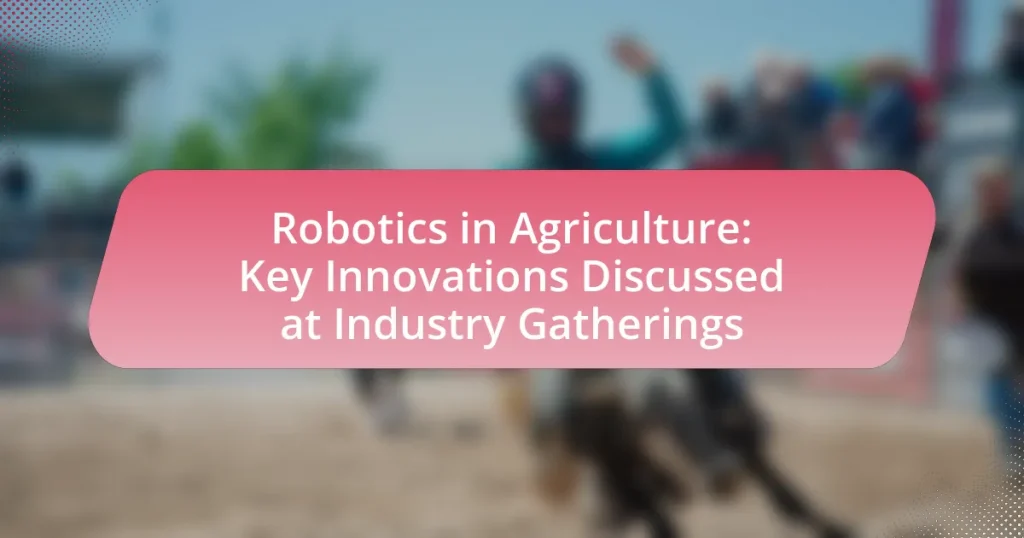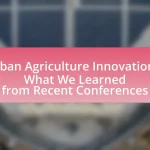The article focuses on key innovations in robotics for agriculture, highlighting advancements such as autonomous tractors, drone technology, and robotic harvesters. These technologies are transforming agricultural practices by enhancing efficiency, precision, and sustainability, with studies indicating significant increases in crop yields and reductions in labor costs. The article also discusses the role of industry gatherings in showcasing these innovations, the challenges faced in adopting robotics, and the economic factors influencing their integration into farming operations. Additionally, it examines future trends, including the integration of artificial intelligence, and provides best practices for farmers considering the adoption of robotic solutions.

What are the key innovations in robotics for agriculture?
Key innovations in robotics for agriculture include autonomous tractors, drone technology, and robotic harvesters. Autonomous tractors utilize GPS and AI to perform tasks such as plowing and planting with minimal human intervention, increasing efficiency and precision. Drone technology enables farmers to monitor crop health and optimize resource usage through aerial imaging and data collection. Robotic harvesters are designed to pick fruits and vegetables, significantly reducing labor costs and improving harvest efficiency. These innovations collectively enhance productivity and sustainability in agricultural practices.
How are these innovations transforming agricultural practices?
Innovations in robotics are transforming agricultural practices by enhancing efficiency, precision, and sustainability. For instance, autonomous tractors and drones enable farmers to perform tasks such as planting, monitoring crop health, and applying fertilizers with minimal human intervention. According to a report by the International Society of Precision Agriculture, the use of robotics can increase crop yields by up to 20% while reducing labor costs by 30%. These advancements allow for more accurate resource management, leading to reduced waste and improved environmental outcomes.
What specific technologies are being implemented in modern farming?
Modern farming is implementing technologies such as precision agriculture, drones, autonomous tractors, and IoT sensors. Precision agriculture utilizes data analytics to optimize field-level management regarding crop farming, enhancing yield and reducing waste. Drones are employed for aerial imaging and monitoring crop health, allowing farmers to assess large areas quickly. Autonomous tractors operate without human intervention, increasing efficiency in planting and harvesting. IoT sensors collect real-time data on soil conditions, moisture levels, and crop health, enabling informed decision-making. These technologies collectively improve productivity and sustainability in agriculture.
How do these technologies improve efficiency and productivity?
Robotics in agriculture improves efficiency and productivity by automating labor-intensive tasks such as planting, harvesting, and monitoring crops. This automation reduces the time and labor costs associated with these activities, allowing farmers to allocate resources more effectively. For instance, a study by the International Society of Precision Agriculture found that the use of robotic systems can increase crop yield by up to 30% while decreasing labor costs by 20%. Additionally, robotics enhances precision in farming practices, leading to better resource management and reduced waste, which further contributes to overall productivity gains.
What role do industry gatherings play in showcasing these innovations?
Industry gatherings play a crucial role in showcasing innovations in robotics for agriculture by providing a platform for companies to demonstrate their latest technologies and solutions. These events facilitate networking among industry leaders, researchers, and potential investors, fostering collaboration and knowledge exchange. For instance, major agricultural technology expos often feature live demonstrations of robotic systems, allowing attendees to see their practical applications in real-time. This visibility can lead to increased adoption of innovative solutions, as evidenced by the rise in investment in agri-tech startups following such gatherings, highlighting their impact on the industry’s growth and evolution.
Which major events focus on agricultural robotics?
Major events that focus on agricultural robotics include the International Conference on Agricultural Robotics, the Agri-Tech East Innovation Conference, and the World Agri-Tech Innovation Summit. These events gather industry leaders, researchers, and innovators to discuss advancements in agricultural robotics, showcasing technologies that enhance farming efficiency and productivity. For instance, the International Conference on Agricultural Robotics features presentations on cutting-edge robotic systems and their applications in precision agriculture, while the World Agri-Tech Innovation Summit emphasizes collaboration between technology providers and farmers to drive innovation in the sector.
How do these gatherings facilitate knowledge sharing among professionals?
Industry gatherings facilitate knowledge sharing among professionals by providing a platform for networking, discussions, and presentations on the latest advancements in robotics for agriculture. These events enable attendees to exchange insights, experiences, and best practices, fostering collaboration and innovation. For instance, conferences often feature expert speakers who present case studies and research findings, allowing participants to learn about cutting-edge technologies and their applications in real-world scenarios. Additionally, workshops and panel discussions encourage interactive dialogue, where professionals can ask questions and share their challenges, leading to collective problem-solving and enhanced understanding of industry trends.

What challenges do robotics face in the agricultural sector?
Robotics in the agricultural sector face several challenges, including high initial costs, limited adaptability to diverse farming environments, and the need for advanced technology integration. High initial costs can deter farmers from investing in robotic solutions, as many agricultural robots can range from tens of thousands to millions of dollars. Limited adaptability arises because many robots are designed for specific tasks and may struggle to operate effectively in varying conditions, such as different crop types or terrain. Additionally, the integration of robotics with existing agricultural technologies, such as precision farming tools and data management systems, requires significant technical expertise and infrastructure, which can be a barrier for many farmers.
How do economic factors influence the adoption of agricultural robotics?
Economic factors significantly influence the adoption of agricultural robotics by determining the cost-benefit ratio for farmers. High initial investment costs for robotic systems can deter adoption, especially for small-scale farmers with limited capital. Conversely, economic pressures such as labor shortages and rising labor costs can incentivize farmers to invest in robotics to enhance efficiency and reduce reliance on human labor. For instance, a study by the International Society of Precision Agriculture found that farms implementing robotics reported a 20% increase in productivity, demonstrating a clear economic advantage. Additionally, government subsidies and financial incentives can further facilitate the adoption of agricultural robotics by offsetting costs, making technology more accessible to a broader range of farmers.
What are the costs associated with implementing robotic solutions?
The costs associated with implementing robotic solutions in agriculture typically include initial investment, maintenance, and operational expenses. Initial investment costs can range from tens of thousands to several million dollars, depending on the complexity and scale of the robotic systems. For example, a basic robotic harvester may cost around $100,000, while advanced systems with AI capabilities can exceed $1 million. Maintenance costs generally account for 5-10% of the initial investment annually, covering repairs and software updates. Operational expenses, including labor savings and energy consumption, can also impact overall costs, with studies indicating that robotic solutions can reduce labor costs by up to 50% over time.
How do farmers perceive the return on investment for these technologies?
Farmers generally perceive the return on investment for agricultural robotics as positive, citing increased efficiency and productivity as key benefits. A survey conducted by the American Farm Bureau Federation found that 70% of farmers who adopted robotic technologies reported improved labor efficiency, which directly correlates to higher yields and reduced operational costs. Additionally, farmers recognize that while the initial investment can be substantial, the long-term savings and enhanced crop management capabilities justify the expenditure. This perception is supported by case studies showing that farms utilizing robotics have seen a 20-30% increase in output, further validating the favorable ROI outlook among farmers.
What technical challenges must be overcome for successful integration?
Successful integration of robotics in agriculture faces several technical challenges, including interoperability, data management, and scalability. Interoperability issues arise when different robotic systems and agricultural equipment cannot communicate effectively, hindering seamless operation. Data management challenges involve the collection, processing, and analysis of vast amounts of data generated by robotic systems, which is crucial for informed decision-making. Scalability concerns relate to the ability to expand robotic solutions across various agricultural settings without significant modifications. Addressing these challenges is essential for maximizing the benefits of robotics in agricultural practices.
What are the limitations of current robotic technologies in agriculture?
Current robotic technologies in agriculture face limitations such as high costs, limited adaptability to diverse crops, and challenges in navigating complex environments. High costs hinder widespread adoption, as many farmers cannot afford the initial investment. Limited adaptability means that many robots are designed for specific tasks or crops, reducing their utility across different agricultural settings. Additionally, challenges in navigating complex environments, such as uneven terrain or obstacles, restrict the effectiveness of these robots in real-world farming scenarios. These limitations collectively impact the efficiency and scalability of robotic solutions in agriculture.
How can these limitations be addressed through innovation?
Limitations in robotics for agriculture can be addressed through innovation by developing advanced algorithms and machine learning techniques that enhance the adaptability and efficiency of robotic systems. For instance, precision agriculture technologies utilize data analytics to optimize resource use, thereby overcoming challenges related to crop variability and environmental conditions. Research from the International Journal of Agricultural Robotics indicates that integrating AI-driven decision-making processes can significantly improve the performance of agricultural robots, leading to increased yield and reduced waste.

What future trends can we expect in agricultural robotics?
Future trends in agricultural robotics include increased automation, enhanced precision agriculture, and the integration of artificial intelligence. Automation is expected to streamline tasks such as planting, harvesting, and monitoring crops, reducing labor costs and increasing efficiency. Enhanced precision agriculture will utilize robotics to optimize resource use, improving yield while minimizing waste. The integration of artificial intelligence will enable robots to analyze data in real-time, making informed decisions that adapt to changing conditions. These trends are supported by advancements in sensor technology and machine learning, which are driving innovation in the agricultural sector.
How is artificial intelligence shaping the future of agricultural robotics?
Artificial intelligence is significantly shaping the future of agricultural robotics by enhancing precision farming, automating labor-intensive tasks, and improving decision-making processes. AI algorithms analyze vast amounts of data from sensors and drones, enabling robots to perform tasks such as planting, weeding, and harvesting with greater accuracy. For instance, a study by the International Journal of Agricultural Robotics found that AI-driven robots can increase crop yields by up to 30% while reducing resource usage by 20%. This integration of AI not only boosts efficiency but also supports sustainable farming practices, making agriculture more resilient to climate change and market fluctuations.
What advancements in AI are being integrated into agricultural robots?
Advancements in AI integrated into agricultural robots include machine learning algorithms for crop monitoring, computer vision for pest detection, and autonomous navigation systems for precision farming. Machine learning enables robots to analyze vast amounts of data from sensors and cameras, improving decision-making regarding irrigation and fertilization. Computer vision allows robots to identify and classify pests and diseases in real-time, enhancing crop health management. Autonomous navigation systems facilitate efficient movement across fields, optimizing resource use and reducing labor costs. These technologies collectively enhance productivity and sustainability in agriculture.
How will AI enhance decision-making in farming operations?
AI will enhance decision-making in farming operations by providing data-driven insights that optimize resource allocation and crop management. Through the use of machine learning algorithms, AI can analyze vast amounts of data from various sources, such as weather patterns, soil conditions, and crop health, enabling farmers to make informed decisions. For instance, a study by the International Food Policy Research Institute found that AI-driven precision agriculture can increase crop yields by up to 30% while reducing input costs by 20%. This demonstrates that AI not only improves efficiency but also contributes to sustainable farming practices.
What best practices should farmers consider when adopting robotics?
Farmers should prioritize thorough training and integration of robotics into their existing workflows when adopting this technology. Effective training ensures that operators understand the capabilities and limitations of robotic systems, which can enhance productivity and reduce errors. Additionally, integrating robotics with current agricultural practices allows for seamless operation and maximizes the benefits of automation. Research indicates that farms that invest in comprehensive training programs and strategic integration see a 20-30% increase in efficiency and yield, demonstrating the importance of these best practices in successful robotic adoption.
How can farmers effectively evaluate robotic solutions for their needs?
Farmers can effectively evaluate robotic solutions for their needs by conducting a thorough assessment of their specific agricultural tasks, budget constraints, and the technological capabilities of available robotic systems. This evaluation process should include identifying the specific tasks that can be automated, such as planting, harvesting, or pest control, and determining the expected return on investment based on increased efficiency and reduced labor costs.
Farmers should also consider the compatibility of robotic solutions with existing equipment and practices, as well as the level of technical support and training provided by manufacturers. Research indicates that farmers who engage in pilot testing or demonstrations of robotic systems can better understand their functionality and suitability for their operations. For instance, a study by the University of California found that hands-on experience with robotic technology significantly improved farmers’ confidence in adopting these innovations.
What strategies can be employed to ensure successful implementation?
To ensure successful implementation of robotics in agriculture, organizations should adopt a multi-faceted strategy that includes thorough training, stakeholder engagement, and continuous evaluation. Training programs for farmers and operators are essential, as they enhance the understanding and effective use of robotic technologies, leading to increased productivity. Engaging stakeholders, including farmers, technology providers, and agricultural experts, fosters collaboration and ensures that the solutions meet real-world needs. Continuous evaluation of the implemented systems allows for adjustments based on performance metrics and feedback, ensuring that the technology remains effective and relevant. These strategies are supported by case studies showing that farms that invested in training and stakeholder collaboration reported a 20% increase in operational efficiency within the first year of implementation.















